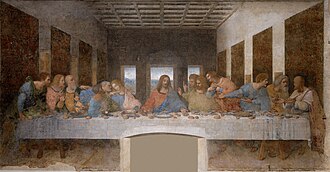Last Supper
| Christ died for our articles about Christianity |
| Schismatics |
| Devil's in the details |
The Last Supper generally refers to the final meal Jesus had with his apostles and is the basis for the Eucharist and Maundy Thursday of the Holy Week. It is based on biblical references from the Gospels as well as Corinthians.
It may also refer to several famous works depicting the scene, specifically Leonardo da Vinci's Last Supper.
The Bible[edit]
According to the New Testament, the Last Supper is the last meal Jesus had before his arrest and Crucifixion and the basis of the Eucharist. The Bible contradicts itself; the Gospel of Luke, Gospel of Mark, and Gospel of Matthew say it happened on day 1 of the Passover, while the Gospel of John puts it the day before Passover. Paul of Tarsus says he got a personal revelation about the Lord’s Supper (1 Corinthians 11:23). The slaying of the sacrificial bull in Mithraism parallels the sacrificial slaying of Jesus.[1][2]
However, if the Last Supper happened the night before Jesus' crucifixion on Good Friday, it could not have been the Seder because the first night of Passover can never fall on a Thursday![]() . The first night of Passover can fall on a Friday night, which lends more credibility to John's assertion than the other three.
. The first night of Passover can fall on a Friday night, which lends more credibility to John's assertion than the other three.
Fresco[edit]
The Last Supper is, as stated above, a huge-ass fresco painted by Leonardo da Vinci during the 1490s. It hangs in the Santa Maria delle Grazie church in Milan. It depicts Jesus' last meal with his apostles before his crucifixion. The apostle to the left of Jesus is purported to be St. John, albeit with a hint of femininity. The fresco contains much symbolism and is controversially interpreted in Dan Brown's novel, The Da Vinci Code.
Is that a woman?[edit]
One fantastical "controversial" aspect of the Last Supper is the gender of the figure commonly identified as St. John and whether it is, in fact, Mary Magdalene. Much debate concerning St. John's gender stems from The Da Vinci Code and the book it plagiarized that covered conspiracies regarding Jesus before it.
In the fresco, St. John is depicted in a very feminine way. Sadly for conspiracy theorists and Dan Brown enthusiasts, conventions of the day[3] were to paint younger men in an effeminate way, and Da Vinci was no stranger to painting men quite effeminately - even to the point where some people believe that the Mona Lisa is actually a Bloke and not a Sheila. There would also be a considerable problem because the painting was commissioned to depict Jesus and his 12 followers, and as there are only 13 people in the painting, the inclusion of Magdalene would have to be at the expense of another apostle. This blatant oversight would have been noticed when the fresco was commissioned.
See also[edit]
External links[edit]
References[edit]
- ↑ http://www.infidels.org/library/modern/paul_carlson/nt_contradictions.html
- ↑ http://www.farvardyn.com/mithras4.php
- ↑ The Florentine School and the Portrayal of Male Youth -http://arthistory.about.com/od/renaissanceart/a/altheyoungdudes.htm

